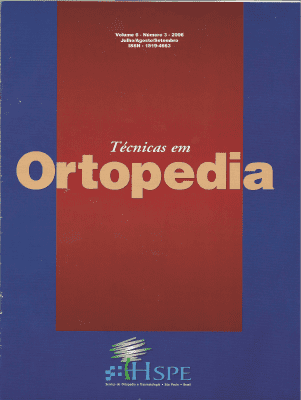Instabilidade femoropatelar juvenil
Uma nova proposta de tratamento
Palavras-chave:
Instabilidade femoropatelar, Reforço reticular lateral, Enxerto do tendão semitendinídeoResumo
Dores de origem femoropatelar em crianças e adolescentes ocorrem normalmente devido a desalinhamentos e instabilidades patelares. Este trabalho propõe, em desalinhamentos maiores, a associação de técnicas que retencio nem partes moles evitem agressão em estruturas fisárias. Efetua-se a liberação do retináculo lateral, reforço de dois estabilizadores estáticos, LPFM (ligamento patelofemoral medial) e o LPTM (ligamento patelo-tibial medial) com enxerto de semitendinoso não desinserido da tíbia associados ao retencionamento do vasto-medial oblíquo. Redirecionando os vetores de força, obtemos uma resultante que promove melhora na excursão patelo-femoral. Objetivamos, com o uso desta técnica, elevar o arsenal cirúrgico-terapêutico da instabilidade pardo-femoral em crianças e adolescentes.
Downloads
Referências
McCall, Richard E, Ratts, Victoria, R. N. Soft-Tissue Realignment for Adolescem Patellar Instabilicy, J Pediatr Orthop 1999; 19(4): 549-552.
Deie M, Ochi M, Sumen Y, Yasumoto M, Kobayashi K, Kimura H. Reconstruction of the medial patellofemoral ligament for the treatmenc of habitual or recurrent dislocation of the patella in children. J BoneJoint Surg (Br) 2003; 85: 887-890.
Letts R M, Davidson D, Beaule P. Semitendinosus Tenodesis for Repair of Recurrent Dislocation of the Patella in Children.J Pediatr Orchop 1999; 19: 742.
Davis D K, Fithian D C. Techniques of Medial Retinacular Repair and Reconstruction. Clin Orthop 2002; 1(402):38-52.
Beasley L S, Vidal A F. Traumatic patellar dislocation in children and adolescents: treatment update and literature review. Curr Opin Pediatr 2004; 16(1):29-36.
Dandy DJ. Chronic Patellofemoral Instability.J. BoneJoint Surg (B) 1996; 78, 328-335.
Andrada AJ, Springgins A J. The medial patellofemoral ligament (MPFL) and its relevance in the treatment of acure lateral patellar dislocation.J. BoneJoint Surg(Br) 2002; 84-suplplement III, 264.
Baker R H, Carrol N, Dewar F P, HallJ E. The semitemdinossus tenodesis for recurrent disclocation ofthe patella. J. BoneJoinc Surg(B) 1972; 54, 103-109.
Young D, Hill G, Peters T. Reconstruction of the medial patellofemoral ligament in recurrent dislocation of patella. J. BoneJoint Surg(Br) 2001; 83-B supplement III, 322-323.
Nomura E. Classifi.cation of lesions of the medial patello-femoral ligament in patellar dislocation. Internacional Orthopaedics (SICOT ) 1999; 23:260-263.
Muneta T, Sekiya I, Tsuchiya M, Shinimiya K. A technique for reconstruction of the medial patellofemoral ligament. Clin Orthop 1999; 1(359): 151-155.
Larson R L. Subluxation-dislocation of the patella. ln: KennedyJC, ed. The injured adolescem knee. Baltimore: Williams & Wilkins, 202-204. 1979.
Kujala UM,Jaakkola L H, Koskinem S K, Taimela S, Hurme M, Nelimarkka O. Scoring of patellofemoral disorders. Arthroscopy 1993; 9(2):159-163.
Hautamaa P V, Fithian D C, Kaufman K R, Daniel D M, Pohlmeyer A M. Medial soft tissue restraincs in lateral pate!lar instabilicy and repair. Clin Orchop 1998; 1(349):174-182.
Terry G C. The anacomy of the extensor mechanism. Clin Sports Med 1989; 8: 163-177.
Marczyk L R S, GomesJ L E. Instabilidade femoro-patelar: conceitos acuais. Rev Bras Ortop. 2000; 35: 275-281.





